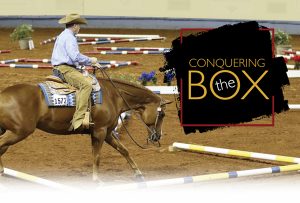Conquering The Box
Click here to read the complete article
134 – March/April, 2022
At first glance, the box is pretty basic: you walk, trot, or lope into the box. Turn and exit. So why is achieving a ‘plus’ so elusive in this simple square drawn in the dirt by four poles?
Sure, it’s a small space, so not ticking poles or stepping out is a challenge. Then, there’s the oddity of it not being your ordinary pivot turn. Rather your horse has to swap ends by arcing his body and turning on the forehand and haunches at the same time. But even with those individual pieces in their toolbox, riders fail to earn points, or even find they lose points in the box. The consensus among top Trail experts is that to master the box, one must master the flow.
Tim Kimura knows a thing or two about the box’s ability to challenge and reward. “Everyone thinks that fast turns are the spark in the deal,” he says. “But really, it’s broken into three parts: entrance, turn, exit. To score high, the three parts have to match. If you have a fast turn, and then your horse doesn’t want to walk out of the box because he’s a little nervous about that pole, then I get disappointed about that. If your horse is creepy crawly getting into the box, I’m a little offended by that, too. I want to see the tempo, the music, and moves that match as you work through it. I want to see the horse give me good footwork–front and back–all the time. You have to get in right, turn right, finish the turn, square up, and step off all with a cadenced footfall.”
Trail exhibitors may have noticed that the box has gotten a little bigger over the years. Kimura and other designers often use a 7-foot box now. He likes how the bigger box presents riders with a choice after completing the turn. He describes, “Do you take an extra half step and walk out? Or do you take a long step to exit? Which is better for your horse?” He personally likes to half step out of the box so the horse can balance out before continuing. “The back leg is left so far back after turning. A half step allows it to catch up to the front before exiting. But if a horse can step out high and that back leg follows him, then that could be a more credit-earning move.”
Click here to read the complete article
134 – March/April, 2022











